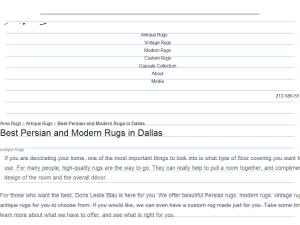Tibetan Rugs
Tibetan Rugs
Serving
New York,, NY 10022
Serving
New York,, NY 10022
Category: Rugs
Rug Store
Looking at the dramatic, mountainous and awe-inspiring landscape of Tibet one may easily forget its painful past and the toll it took upon its people. Nevertheless, this deeply spiritual region is the place where the craft of weaving Tibetan rugs has flourished for centuries, bringing to the world stunning art pieces desired by travellers and collectors alike. Oriental Tibetan carpets have a long an profound history which stretches back hundreds if not thousands of years.
Truth be told, Tibetan rug weaving started off as a lowly craft which was not mentioned in early writings, aside from occasional references to the rugs owned by prominent religious figures. Some notions of original Tibetan rugs sold to the western countries began appearing in the 1880’s. However, it wasn’t until the beginning of the 20th century that the first detailed accounts of Tibetan rug weaving came from foreigners who entered Tibet with the British Invasion and described a workshop they encountered near Gyantse, en route to Lhasa.
In 923 AD, the people of Tingri and Saga popularized the “Lhaewu” or "Glide" – a craft which was the base for the later creation of the authentic Tibetan technique. In the early 11th century, Nyachi in Shigatse, a region located in western Tibet, was the main center of rug production in the country. It is there, the development of the craft was initiated to reached its final stage in the 17th century. The majority of rug-making workshops used to be owned by aristocratic families and supplied monasteries with expertly woven goods. Much simpler Tibetan rugs for domestic use were usually made at home with cheaper materials than those meant for religious usage.
Keywords: Rug Store, Moroccan rug, modern rugs, blue rug, antique rugs, vintage rugs, oushak rugs, contemporary rugs, square rugs, mid century modern rugs, persian carpet, art deco rug, indian rugs, scandinavian rugs, tabriz rug, antique oriental rugs, oversized area rugs, khotan, extra large rugs, New York, NY.
Looking at the dramatic, mountainous and awe-inspiring landscape of Tibet one may easily forget its painful past and the toll it took upon its people. Nevertheless, this deeply spiritual region is the place where the craft of weaving Tibetan rugs has flourished for centuries, bringing to the world stunning art pieces desired by travellers and collectors alike. Oriental Tibetan carpets have a long an profound history which stretches back hundreds if not thousands of years.
Truth be told, Tibetan rug weaving started off as a lowly craft which was not mentioned in early writings, aside from occasional references to the rugs owned by prominent religious figures. Some notions of original Tibetan rugs sold to the western countries began appearing in the 1880’s. However, it wasn’t until the beginning of the 20th century that the first detailed accounts of Tibetan rug weaving came from foreigners who entered Tibet with the British Invasion and described a workshop they encountered near Gyantse, en route to Lhasa.
In 923 AD, the people of Tingri and Saga popularized the “Lhaewu” or "Glide" – a craft which was the base for the later creation of the authentic Tibetan technique. In the early 11th century, Nyachi in Shigatse, a region located in western Tibet, was the main center of rug production in the country. It is there, the development of the craft was initiated to reached its final stage in the 17th century. The majority of rug-making workshops used to be owned by aristocratic families and supplied monasteries with expertly woven goods. Much simpler Tibetan rugs for domestic use were usually made at home with cheaper materials than those meant for religious usage.
Keywords: Rug Store, Moroccan rug, modern rugs, blue rug, antique rugs, vintage rugs, oushak rugs, contemporary rugs, square rugs, mid century modern rugs, persian carpet, art deco rug, indian rugs, scandinavian rugs, tabriz rug, antique oriental rugs, oversized area rugs, khotan, extra large rugs, New York, NY.
Customer Reviews for Tibetan Rugs
Be the first to review Tibetan Rugs - Use the thumbs to get started!
Tibetan Rugs has not yet completed their interview.
- ©2025 AlbanyCountyNYBusinessList.com
- Privacy Policy
- FAQ
- Contact
This site has been visited 18,525 times

